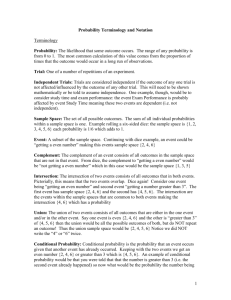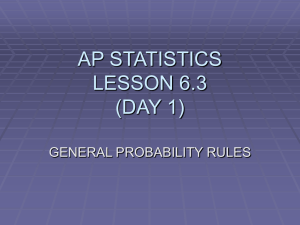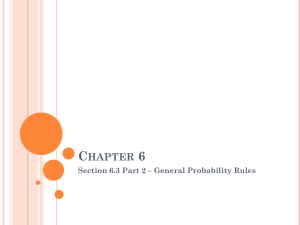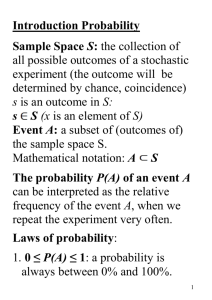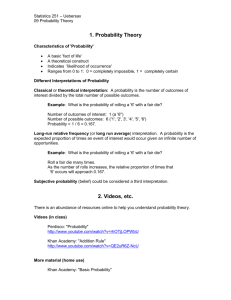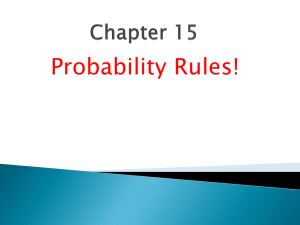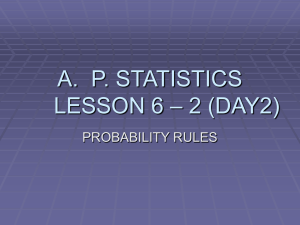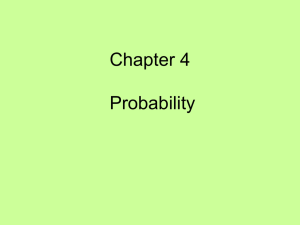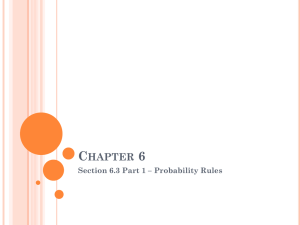Probability Chapter 5 Key: Definitions, Rules, & Simulation
advertisement
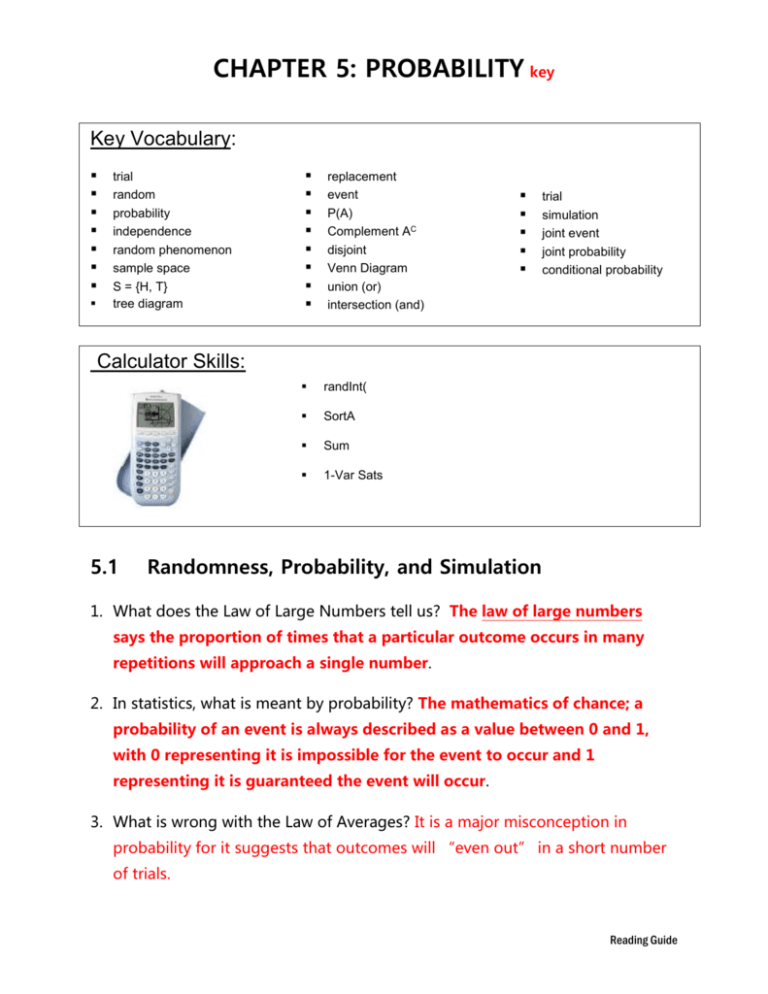
CHAPTER 5: PROBABILITY key
Key Vocabulary:
trial
random
probability
independence
random phenomenon
sample space
S = {H, T}
tree diagram
replacement
event
P(A)
Complement AC
disjoint
Venn Diagram
union (or)
intersection (and)
trial
simulation
joint event
joint probability
conditional probability
Calculator Skills:
5.1
randInt(
SortA
Sum
1-Var Sats
Randomness, Probability, and Simulation
1. What does the Law of Large Numbers tell us? The law of large numbers
says the proportion of times that a particular outcome occurs in many
repetitions will approach a single number.
2. In statistics, what is meant by probability? The mathematics of chance; a
probability of an event is always described as a value between 0 and 1,
with 0 representing it is impossible for the event to occur and 1
representing it is guaranteed the event will occur.
3. What is wrong with the Law of Averages? It is a major misconception in
probability for it suggests that outcomes will “even out” in a short number
of trials.
Reading Guide
CHAPTER 5: PROBABILITY key
4. What is simulation? Simulations are probability models used to imitate chance
behavior or processes and to estimate probabilities.
5. List the four steps for conducting a simulation:
STATE: Identify the question of interest about the chance process
PLAN: Describe how to use a chance device to imitate a repetition of the
chance behavior
DO: Perform many repetitions of the simulation
CONCLUDE: Use the results of the simulation to answer the question of
interest
5.2 Probability Rules
1. In statistics, what is meant by an independent trial? The occurrence of the trial
is not affected by any other trial
2. What is a sample space? A sample space includes all possible outcomes of a
chance process.
3. What is an event? An event is a subset of the sample space and can be
labeled as any collection of outcomes from some chance process.
4. Explain why the probability of any event is a number between 0 and 1. The
probability of an event is the long-run proportion of repetitions on which that
event occurs. Since any proportion is a number between 0 and 1, so are
probabilities.
5. What is the sum of the probabilities of all possible outcomes? One
Reading Guide
CHAPTER 5: PROBABILITY key
6. Describe the probability that an event does not occur? What is it called? The
probability that an event does not occur is 1 minus the probability that the
event does occur. It is called the complement of an event.
7. When are two events considered disjoint? What is another term for disjoint?
Two events are considered disjointed when they have no outcomes in
common. Another term for disjoint is ‘mutually exclusive’.
8. What is the probability of two mutually exclusive events? If two events have
no outcomes in common, the probability that one or the other occurs is the
sum of their individual probabilities.
9. What is meant by the union of two or more events? Illustrate on a Venn
diagram. The union (A ∪ B) of events A and B consists of all outcomes in
event A, event B, or both.
10. State the addition rule for disjoint events. Illustrate on a Venn diagram.
Addition rule for mutually exclusive events: If A and B are mutually
exclusive,
P(A or B) = P(A) + P(B).
Reading Guide
CHAPTER 5: PROBABILITY key
11. State the general addition rule for unions of two events. The general addition
rule can be used to find P(A or B):
P(A or B) = P(A) + P(B) – P(A and B)
12. Explain the difference between the rules in 10 and 11. The rule in number 10
is for independent or mutually exclusive events. The rule in number 11 is for
non-independent of non-mutually exclusive events.
13. Summarize the 5 Rules of Probability.
For any event A, 0 ≤ P(A) ≤ 1.
If S is the sample space in a probability model, P(S) = 1.
In the case of equally likely outcomes,
number of outcomes corresponding to event A
P(A) =
total number of outcomes in sample space
Complement rule: P(AC) = 1 – P(A)
Addition rule for mutually exclusive events: If A and B are mutually
exclusive, P(A or B) = P(A) + P(B).
14. What is meant by the intersection of two or more events? Illustrate on a Venn
diagram. The intersection of events A and B (A ∩ B) is the set of all
outcomes in both events A and B.
15. Explain the difference between the union and the intersection of two or more
events. The union of two or more events includes all outcomes in the events.
The intersection, however, only includes the outcomes that the events have in
common.
Reading Guide
CHAPTER 5: PROBABILITY key
5.3
Conditional Probability and Independence
1. What is meant by conditional probability? When we are trying to find the
probability that one event will happen under the condition that some other
event is already known to have occurred, we are trying to determine a
conditional probability.
2. When are two events considered independent? State the formula used to
determine if two events are independent? When knowledge that one event
has happened does not change the likelihood that another event will happen,
we say the two events are independent. P(A | B) = P(A) and P(B | A) = P(B).
3. State the general multiplication rule for any two events. The probability that
events A and B both occur can be found using the general multiplication
rule:
P(A ∩ B) = P(A) • P(B | A) where P(B | A) is the conditional probability that
event B occurs given that event A has already occurred.
4. What is the multiplication rule for independent events? When events A and B
are independent, we can simplify the general multiplication rule since P(B| A)
= P(B).
Multiplication rule for independent events: If A and B are independent
events, then the probability that A and B both occur is: P(A ∩ B) = P(A) • P(B)
5. How is the general multiplication rule different than the multiplication rule for
independent events? The general multiplication rule includes conditional
probability. The multiplication rule for independent events cannot be
conditional and independent; therefore, conditional probability is not
included in the latter.
Reading Guide
CHAPTER 5: PROBABILITY key
6. Can mutually exclusive events be independent? Two mutually exclusive
events can never be independent simply because if one event happens, then
the other event is guaranteed NOT to happen.
7. What is the opposite of at least one? None
8. State the formula for finding conditional probability. The conditional
probability formula states: P(B|A) = P(A ∩ B) / P(A).
9. Explain how to set up a tree diagram. Tree diagrams can be used to describe
sample spaces, provided that the alternatives are not too numerous. Once
the sample space is illustrated, the tree diagram can be used for determining
probabilities. The probabilities for an event and NOT for an event are marked
on the branches of the tree. All outcomes are represented and the
probabilities of each outcome are obtained by multiplying the probabilities
along that path.
10. What is meant by joint probability? Joint probability is used in multi-stage
experiments when we want to find out how likely it is that two (or more) events
happen at the same time. An example is drawing three cards and getting all jacks
P(JJJ). We can use a tree diagram to figure out this type of probability. This type
of probability depends on whether the experiment is done with or without
replacement.
Reading Guide


